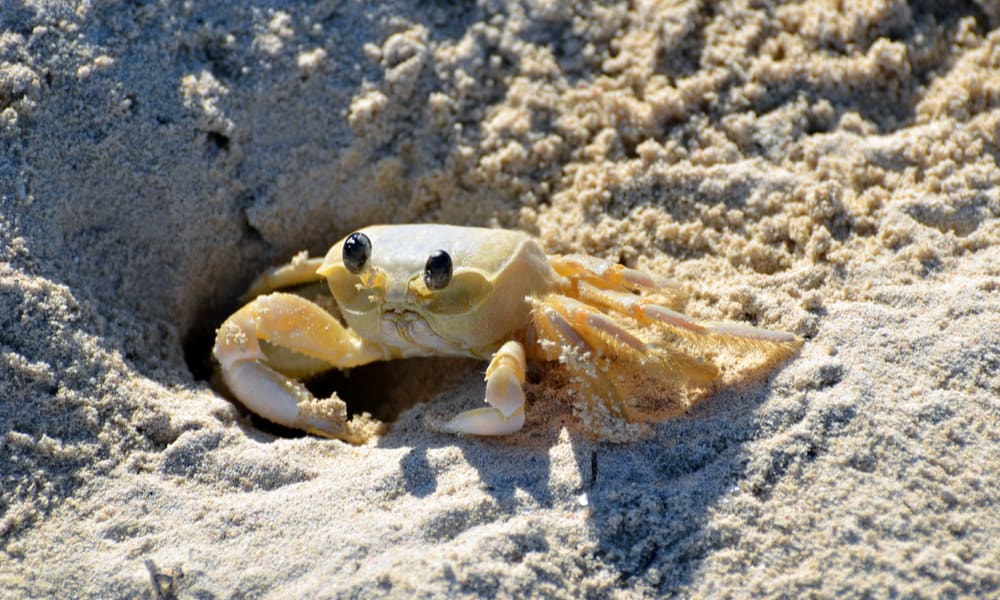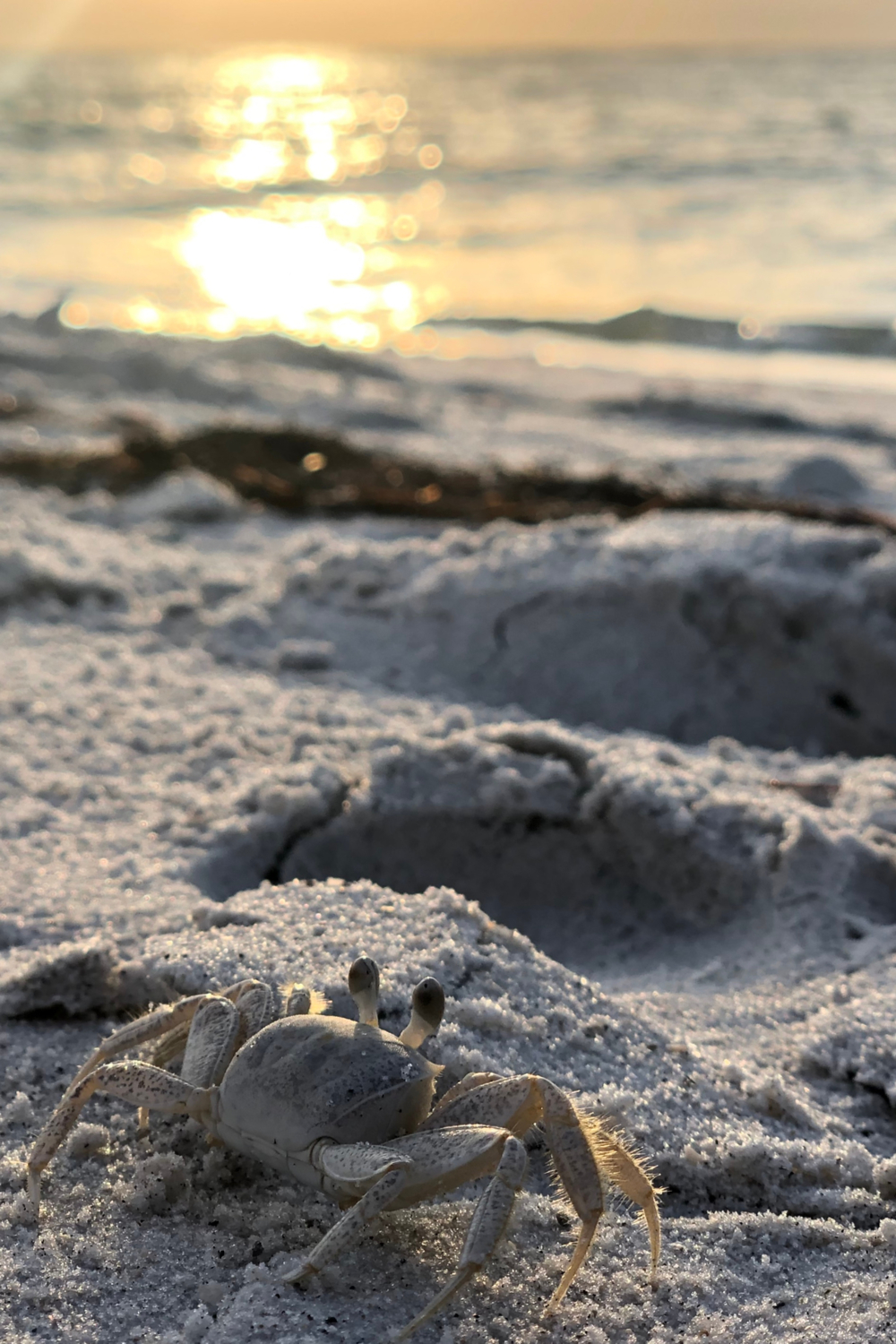Sand crabs are miniature crustaceans often referred to as sand bugs, sand fleas, or mole crabs. They will spend the majority of their life buried deep within the send. The animal’s gray shell allows them to meld with the environment becoming almost invisible to the onlookers.
In this article, we will review what do sand crabs eat and will share some intriguing facts about this tiny animal.
Sand Crabs Habits and biology
An interesting thing about this animal is that, unlike other crabs, they only move backward. They cannot walk laterally or forward, nor do they have claws characteristic of crab species.
Sand crabs (scientifically Emerita) have bodies in a shape of a barrel. Their exoskeleton is rather tough, but that doesn’t stop other aquatic species from hunting it. To survive, the crab relies on camouflage and its ability to roll with the current. The animal looks for detritus and plankton by relying on its antennae.
The male crabs are smaller than their female counterparts. Males of certain subspecies latch onto the legs of females as they carry them around. As mentioned, the species is very tinny; their carapace is between 0.3 and 1.5 inches long.
Here are some of its common habits:
- The animal is a very fast and efficient burrower. They need just 1.5 seconds to completely disappear in the sand with only their antennae and eyes sticking out. When burrowing, they will start with their tail end. The species utilizes pereiopods for digging the sand beneath it.
- Sand crabs rely on the tide for movement. They don’t have legs they can rely on, so the species moves by being carried around by the water current.
- Like with everything else, sand crabs are dependent on the tide for eating. Once they bury themselves, they will utilize the antennae to collect passing food particles.
- The species needs to rely on its speed for survival. Besides being fast burrowers, their fast antennae allow them to collect food several times during one wave.
- Sand crabs are proficient at reading the waves and movement of the sand. Based on that, they can decide when to dig themselves out to be carried by the waves into some other direction.
What do sand crabs eat in the wild?
The animal doesn’t hunt; it only collects passing food particles. Unlike most other crab species that utilize claws for hunting, sand crabs use their antennae. Given that they lack traditional legs, these are considered almost as appendages of a sort.
Sand crabs are fast when collecting food, and they can eat their fill during a few tidal waves. Experts consider them as motile filter-feeders commonly located in the surf swash zones.
When a wave comes around, the crab will pop out from the sand and glide on it for several feet. Once it finds a suitable spot, it will use its abdomen to quickly burrow into the sand. As the water recedes, it will carry around small plankton and detritus. The animal will extend its antenna from water to capture these particles before the wave takes them again.
They will repeat this process with every wave or two. Therefore, it is crucial for the species to stay in the swash zone. Sand crab stays away from rocks and any other interference; they only live in clean sand as anything else would interfere with their ability to burrow and thus, eat.
Here are the things that are a part of their diet:
- Plankton
- Detritus
- Shrimp
Sand crabs require a combination of minerals and protein. Calcium is especially important for them as it plays a crucial role in developing and preservingof the exoskeleton. They also need some vitamins. The crab can eat a lot during the day.
Facts about sand crabs
Sand crabs are unique in the animal world. Although some animal species rely on sand for a cover, none of them use it in such a manner. In many ways, they are dependent on the tide and its whim. Here are some of the most intriguing facts about the species:
- You can easily notice this species in the sand and dig them out. During the summer, you can just sit on a beach and wait for the ocean to recede. In certain locations, there will be lots of them in the sand.
- This species is completely harmless both to people and other animals. If you catch and put it in your hand, it won’t bite, nor will it try to harm you in any way. Instead, it will try to burrow into your hand as if it’s sand.
- Some people try having sand crabs as pets. This is a really bad idea as they need an ocean environment for survival. Also, you cannot recreate their feeding pattern as you can’t have waves in an aquarium tank.
- Crabs’ exoskeleton is in the color of the sand. On the other hand, their eggs are bright orange. When a female is ready to give birth, there will be numerous eggs inside her belly. You can spot them by simply turning the crab upside down as they are in the open.
- When feeding, the sand crab will ingest more than just plankton. They will also eat small sand particles. Then, they will filter it out with organs found in their mouth, leaving being balls of sand. This is a crucial step as it allows them to take as many nutrients as possible while removing unnecessary stuff.
- These sand balls can vary in terms of their shape. Based on the pattern, you can determine how long there hasn’t been tide. For example, when the animal creates balls of an intricate shape, it clearly indicates that there hasn’t been a tide for a while.
- Although the species is dependent on water and tide, sand crabs can stay on dry land for a while. As long as their gills are moist, they are able to survive.
- Many people think that burrowing is the thing that sets apart these animals from other types of crabs. However, this isn’t the case, as many other crab species also camouflage in the sand. Instead, what differentiates them is their layout of legs and pincers.
- Given their small stature, it makes sense that this animal is prey to many larger species. Some of them are gulls, seabirds, shorebirds, octopuses, raccoons, and sea otters.
- Occasionally, the sand crab will behave like a parasite attaching to sea cucumbers, mussels, oysters, and other species. At the same time, they will also serve as a parasitic source of food. They can be a host to certain types of worms that otherwise infest shorebirds. The most common parasitic worms are Profilicollis altmani and Microphallus nicolli. These animals will inhabit the crab’s body cavity, otherwise known as hemocoel. If it’s a larger crab, it is normal for them to have several worms simultaneously. Females are especially susceptible to this threat.
- This animal reproduces from February to August. During courtship, males have a very interesting habit of waving to females from within their burrows. The crabs can mate either in their sand burrows or on the surface. Once it’s over, a female will lay eggs within these holes. A female sand crab can lay eggs once or twice a year. Another role that male has is to fertilize the eggs.
- These animals can communicate by drumming their claws and by performing specific movements.
- You can find this species in various parts of the Americas. They live on the southern coasts in Chile and Argentina but can also be found all the way north in Alaska. However, they are less common from Oregon upwards.
- These crabs have the form of an egg. Although they have a strong exoskeleton, consisting of chitinous and bony cases, it does very little to protect them from underwater predators. Besides antennae, which are important for various processes, they also have three front teeth for feeding. When you touch the carapace, it will feel very smooth. The only exceptions are small ridges located on the anterior portion of their shield.
- The animal’s ability to burrow is not unique but is somewhat special. They are one of the quickest burrowers in the animal kingdom. As such, they were an inspiration to many people. Some scientists hope to recreate mole crab’s burrowing ability and to implement it in robots. For example, these robots could be used to take samples from the soil, which can be crucial for agriculture and civil engineering.
Summary
Sand crabs are very small yet extremely interesting. Their way of feeding is unique in nature. The species is carnivorous, eating detritus and plankton. Sometimes, they will act as parasites, but they can also be hosts to parasites themselves.
During courtship, the male will wave to the female, inviting her to his burrow. The species uses specific movements to communicate.
Like many small animals, sand crabs are very timid. They are harmless to humans, and you can easily spot them on specific beaches in the South, Central, and North America.

